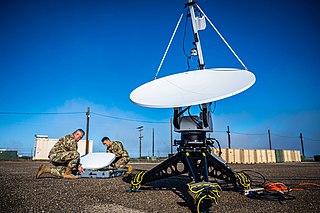
Electromagnetic warfare or electronic warfare (EW) is warfare involving the use of the electromagnetic spectrum or directed energy to control the spectrum, attack an enemy, or impede enemy operations. The purpose of electromagnetic warfare is to deny the opponent the advantage of—and ensure friendly unimpeded access to—the EM spectrum. Electromagnetic warfare can be applied from air, sea, land, or space by crewed and uncrewed systems, and can target communication, radar, or other military and civilian assets.

The M142 HIMARS – M142 High Mobility Artillery Rocket System – is a light multiple rocket launcher developed in the late 1990s for the United States Army and mounted on a standard U.S. Army Family of Medium Tactical Vehicles (FMTV) M1140 truck frame.
The Joint Direct Attack Munition (JDAM) is a guidance kit that converts unguided bombs, or "dumb bombs", into all-weather precision-guided munitions. JDAM-equipped bombs are guided by an integrated inertial guidance system coupled to a Global Positioning System (GPS) receiver, giving them a published range of up to 15 nautical miles (28 km). JDAM-equipped bombs range from 500 to 2,000 pounds. The JDAM's guidance system was jointly developed by the United States Air Force and United States Navy, hence the "joint" in JDAM. When installed on a bomb, the JDAM kit is given a GBU identifier, superseding the Mark 80 or BLU nomenclature of the bomb to which it is attached.

Power projection in international relations is the capacity of a state to deploy and sustain forces outside its territory. The ability of a state to project its power into an area may serve as an effective diplomatic lever, influencing the decision-making processes and acting as a potential deterrent on other states' behavior.

The M270 Multiple Launch Rocket System is an American-developed armored, self-propelled, multiple rocket launcher.

A guided bomb is a precision-guided munition designed to achieve a smaller circular error probable (CEP).

Field telephones are telephones used for military communications. They can draw power from their own battery, from a telephone exchange, or from an external power source. Some need no battery, being sound-powered telephones.

The 2K25 Krasnopol is a Soviet 152/155 mm cannon-launched, fin-stabilized, base bleed-assisted, semi-automatic laser-guided artillery weapon system. It automatically 'homes' on a point illuminated by a laser designator, typically operated by a drone or ground-based artillery observer. Krasnopol projectiles are fired mainly from Soviet self-propelled howitzers such as the 2S3 Akatsiya and 2S19 Msta-S and are intended to engage small ground targets such as tanks, other direct fire weapons, strong-points, or other significant point targets visible to the observer. It can be used against both stationary and moving targets.

A precision-guided munition is a guided munition intended to precisely hit a specific target, to minimize collateral damage and increase lethality against intended targets. During the First Gulf War guided munitions accounted for only 9% of weapons fired, but accounted for 75% of all successful hits. Despite guided weapons generally being used on more difficult targets, they were still 35 times more likely to destroy their targets per weapon dropped.

The AeroVironment Switchblade is a miniature loitering munition designed by AeroVironment and used by several branches of the United States military. Small enough to fit in a backpack, the Switchblade launches from a tube, flies to the target area, and crashes into its target while detonating its explosive warhead. The name Switchblade comes from the way the spring-loaded wings are folded up inside a tube and flip out once released.
Drone warfare is a form of aerial warfare using unmanned combat aerial vehicles (UCAV) or weaponized commercial unmanned aerial vehicles (UAV). The United States, United Kingdom, Israel, China, South Korea, Iran, Italy, France, India, Pakistan, Russia, Turkey, and Poland are known to have manufactured operational UCAVs as of 2019. As of 2022, the Ukrainian enterprise Ukroboronprom and NGO group Aerorozvidka have built strike-capable drones and used them in combat.

The Orlan-10 is a reconnaissance, unmanned aerial vehicle (UAV) developed by the Special Technology Center (STC) in Saint Petersburg for the Russian Armed Forces. The Orlan-10 features a composite fuselage that reduces its radar signature.

The Krasukha is a Russian mobile, ground-based, electronic warfare (EW) system. This system is produced by the KRET corporation on different wheeled platforms. The Krasukha's primary targets are airborne radio-electronics and airborne systems guided by radar. The Krasukha has multiple applications in the Russian Armed Forces.

This is a timeline of the war in Donbas for the year 2020.

The OSCE Special Monitoring Mission to Ukraine was an international civilian observer mission of the Organization for Security and Cooperation in Europe (OSCE) mandated to contribute to reducing tensions and to help foster peace in Ukraine. The mission was deployed in March 2014, following the Russian annexation of Crimea and the outbreak of open conflict in eastern Ukraine. The mission ended on 31 March 2022, following the Russian invasion of Ukraine.

The Bukovel-AD is a Ukrainian anti-drone electronic warfare system.

The ZALA Lancet is an unmanned aerial vehicle (UAV) and loitering munition developed by the Russian company ZALA Aero Group for the Russian Armed Forces. It was first unveiled in June 2019 at the ARMY-2019 military expo in Moscow. It is a further development of the ZALA KYB-UAV loitering munition.
This timeline of the Russian invasion of Ukraine covers the period from 8 April 2022, when the area of heavy fighting shifted to the south and east of Ukraine, to 28 August 2022, the day before Ukraine announced the start of its Kherson counteroffensive.

The EDM4S or EDM4S SkyWiper, is a portable electronic warfare anti-drone device produced and developed by the Lithuanian company NT Service It is designed to disrupt small and medium sized UAVs by jamming their communication and satellite navigation systems with an electromagnetic pulse.

















